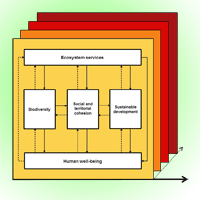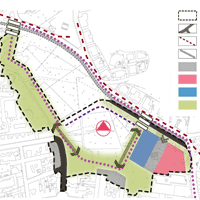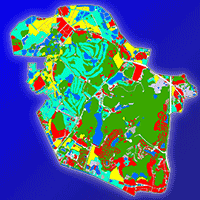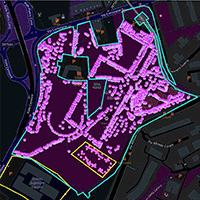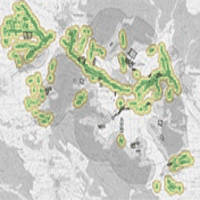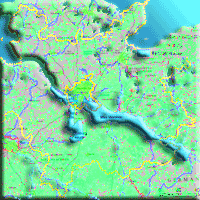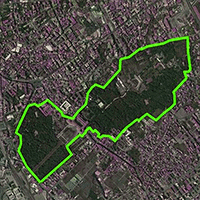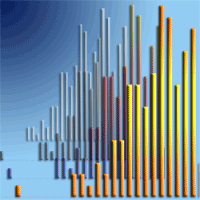
The concept of green infrastructure and urban landscape planning: a challenge for urban forestry planning in Belgrade, Serbia
Nevena Vasiljević (1), Boris Radić (1) , Suzana Gavrilović (1), Biljana Šljukić (2), Milan Medarević (2), Ratko Ristić (3)
iForest - Biogeosciences and Forestry, Volume 11, Issue 4, Pages 491-498 (2018)
doi: https://doi.org/10.3832/ifor2683-011
Published: Jul 18, 2018 - Copyright © 2018 SISEF
Research Articles
Abstract
The beginning of the 21st century has witnessed a growth in our understanding of the importance of planning urban landscapes in the context of urban population growth and unpredictable climatic conditions. In the search for responses to the challenges set by the development of contemporary urban landscapes, researchers have offered solutions based on the concept of sustainable and resilient cities, whose spatial development would be based on an interdisciplinary approach to strategy development: biodiversity, urban ecological networks and connectivity, multifunctionality and modularity. Although the concepts of a green infrastructure, in their spatial and functional dimensions, allow the application of such strategies, there are still problems when it comes to implementation and measuring the results achieved. At the same time, there is a growing discussion of the important role played by urban forestry in the context of the collaborative planning of urban landscapes and the application of the ideas of a green infrastructure. The key question is: what are the modalities of application of the concept of green infrastructure in the process of planning the development of the modern city and how can the resulting benefits be evaluated? With the modalities of application of the concept of green infrastructure in mind, we discuss its multi-scale and multifunctional dimensions as applied in the case of Serbia. The realisation of the green infrastructure concept is presented through the example of the Urban Forest Management Plan for the City of Belgrade - Mladenovac Municipality. The results of using the spatial-ecological approach in creating the plan and establishing connectivity as a new aim in forest management planning show that the implementation of the green infrastructure concept, and the achieved multifunctional ecosystem values, can be presented on the basis of the parameters of landscape metrics. In light of the new urban world, future research should focus on the application of the landscape ecological approach of the green infrastructure concept in collaborative planning at the urban landscape scale, which allows the creation of ecosystem services and benefits to human well-being.
Keywords
Green Infrastructure (GI), Urban Landscape Planning, Urban Forestry, Ecosystem Services, Biodiversity, Recreation, Connectivity
Authors’ Info
Authors’ address
Boris Radić
Suzana Gavrilović
University of Belgrade, Faculty of Forestry, Department of Landscape Architecture and Horticulture, Belgrade (Serbia)
Milan Medarević
University of Belgrade, Faculty of Forestry, Department of Forestry, Belgrade (Serbia)
University of Belgrade, Faculty of Forestry, Department of Ecological Engineering in Soil and Water Resources Protection, Belgrade (Serbia)
Corresponding author
Paper Info
Citation
Vasiljević N, Radić B, Gavrilović S, Šljukić B, Medarević M, Ristić R (2018). The concept of green infrastructure and urban landscape planning: a challenge for urban forestry planning in Belgrade, Serbia. iForest 11: 491-498. - doi: 10.3832/ifor2683-011
Academic Editor
Raffaele Lafortezza
Paper history
Received: Nov 13, 2017
Accepted: May 16, 2018
First online: Jul 18, 2018
Publication Date: Aug 31, 2018
Publication Time: 2.10 months
Copyright Information
© SISEF - The Italian Society of Silviculture and Forest Ecology 2018
Open Access
This article is distributed under the terms of the Creative Commons Attribution-Non Commercial 4.0 International (https://creativecommons.org/licenses/by-nc/4.0/), which permits unrestricted use, distribution, and reproduction in any medium, provided you give appropriate credit to the original author(s) and the source, provide a link to the Creative Commons license, and indicate if changes were made.
Web Metrics
Breakdown by View Type
Article Usage
Total Article Views: 52403
(from publication date up to now)
Breakdown by View Type
HTML Page Views: 42218
Abstract Page Views: 5002
PDF Downloads: 4184
Citation/Reference Downloads: 13
XML Downloads: 986
Web Metrics
Days since publication: 2710
Overall contacts: 52403
Avg. contacts per week: 135.36
Citation Metrics
Article Citations
Article citations are based on data periodically collected from the Clarivate Web of Science web site
(last update: Mar 2025)
Total number of cites (since 2018): 24
Average cites per year: 3.00
Publication Metrics
by Dimensions ©
Articles citing this article
List of the papers citing this article based on CrossRef Cited-by.
References
Green infrastructure - Linking landscapes and communities. Island Press, Washington, DC, USA, pp. 320.
Gscholar
Measuring landscapes. A planner’s handbook. Island Press, Washington DC, USA, pp. 272.
Gscholar
Contributions of cultural services to the ecosystem services agenda. Proceedings of the National Academy of Sciences USA 109 (23): 8812-8819.
CrossRef | Gscholar
Green Infrastructure (GI) - Enhancing Europe’s natural capital. Communication from the Commission to the European Parliament, the Council, the European Economic and Social Committee and the Committee of the Regions, European Commission, 6 May 2013, Brussels, Belgium, pp. 11.
Gscholar
Land mosaics: the ecology of landscapes and regions. Cambridge University Press, USA, pp. 656.
Gscholar
The promise of the ecosystem services concept for planning and decision making. GAIA - Ecological Perspectives for Science and Society 22 (4): 232-236.
CrossRef | Gscholar
Urban forest management plan for the city of Belgrade - Mladenovac Municipality. Faculty of Forestry, University of Belgrade, Secretariat for Environmental Protection, Belgrade, Serbia, pp. 92. [in Serbian]
Gscholar
Ecosystems and human well-being: synthesis. Island Press, Washington DC, USA, pp. 155.
Gscholar
Ecological planning: a historical and comparative synthesis. Johns Hopkins Press, Baltimore and London, pp. 304.
Gscholar
Multifunctional green infrastructure planning to promote ecological services in the city. In: “Urban Ecology Patterns, Processes, and Applications” (Niemela J, Breuste G, Elmqvist T, Guntenspergen G James P, McIntyre T eds). Oxford University Press, New York, USA, pp. 272-285.
Gscholar
Report on best practices for limiting soil sealing and mitigating its effects in EU-27. Technical Report 2011-50, Environment Agency, European Communities, Austria, pp. 231.
Gscholar
The role of landscape connectivity in planning and implementing conservation and restoration priorities. Issues in Ecology 16: 1-20.
Online | Gscholar
Landscape planning and green infrastructure in Serbia: from national to Belgrade city planning. In: Proceedings of “5th Fabos Conference on Landscape and Greenway Planning - Landscapes and Greenways of Resilience” (Valanszki I, Jombach S, Filep-Kovacs K, Fabos JG, Ryan RL, Lindhult MS, Kollanyi L eds). Szent István University, Budapest (Hungary) 01 July 2016. University of Massachusetts, Amherst, MS, USA, pp. 389-397.
Gscholar
Land ecology: an introduction to landscape ecology as a base for land evaluation, land management and conservation. SPB Academic Publishing, Amsterdam, Netherlands, pp. 199.
Gscholar

